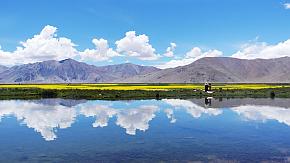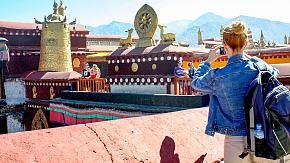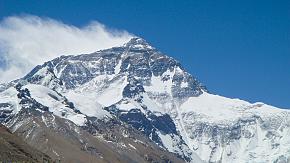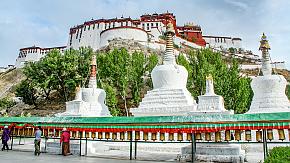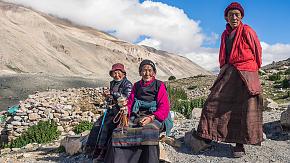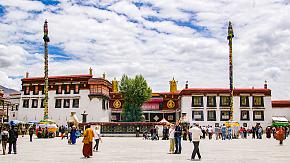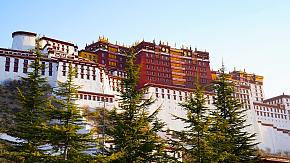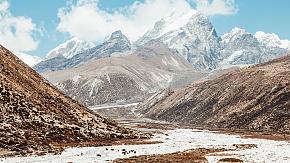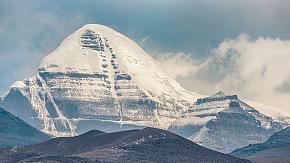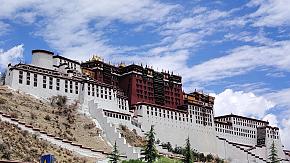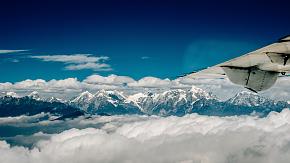Tibet Travel Guide: Top Places, Local Food & Where to Stay
Tibet is a land of high mountains, deep spirituality, and a unique culture. If you're planning to visit Tibet, there's a lot to consider, covering when to visit, what places to see, what to eat, etc. In this guide, we will introduce detailed information about Tibet to help you get a deeper understanding of it and craft your Tibet trip.
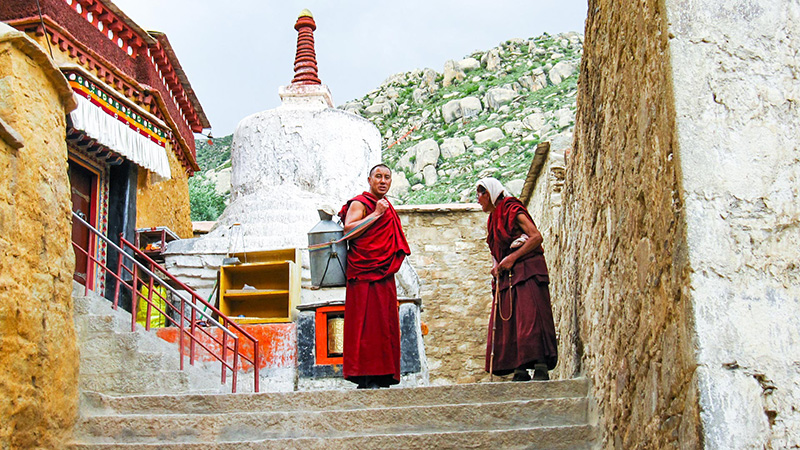 Drepung Monastery in Tibet
Drepung Monastery in Tibet
Best Time to Visit Tibet
The best time to visit Tibet is from April to October. During this time, Tibet is at its most beautiful, with mild weather and pleasant travel conditions. Due to the high altitude, temperatures in Tibet are generally not very high - even in summer, they typically range between 15°C to 25°C (59°F to 77°F). Rainfall is also rare; you may encounter occasional showers, but they usually don't last long.
From November to March, it's winter in Tibet and considered the low season. During this period, prices for accommodation and transportation are much lower. If you want to avoid crowds, winter can be a good time to visit. Many areas remain open in winter, including Potala Palace, Drepung Monastery, and even Everest Base Camp. Unfortunately, Mount Kailash is closed to tourists in winter due to heavy snowfall.
One thing to keep in mind: Tibet sees a surge of domestic tourists during China's public holidays. If you plan to travel during these periods, make sure to book your trip well in advance:
- Labor Day (May 1st-5th)
- Summer Vacation (Late June to late August)
- National Day Holiday (October 1st-7th)
Recommended Tour Itinerary
Top Places to Visit in Tibet
1. Lhasa, Heart of Tibet
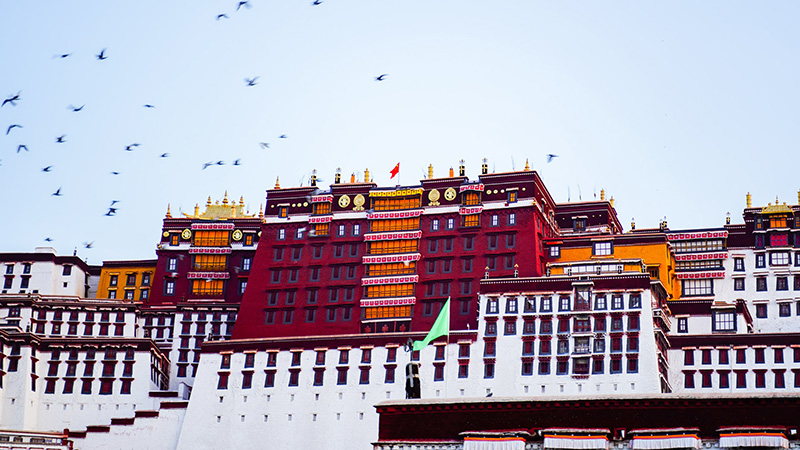 The Potala Palace in Lhasa
The Potala Palace in Lhasa
- Chinese: 拉萨
- Elevation: Around 3,650 m (11,975 ft)
Lhasa is the capital of Tibet and the spiritual and cultural center of the region. If you're traveling to Tibet, the first destination would be Lhasa, as Tibet has the biggest airport that runs most of the national flights from other cities to Tibet in China.
There are many attractions related to Tibetan Buddhism and traditional culture, which attract numerous tourists. Another important thing is that Lhasa has a relatively lower elevation than other cities in Tibet. You may spend a few days here to adjust to the high altitude. Then, continue your journey to higher places.
Highlights in Lhasa:
- The Potala Palace: The most famous landmark in Lhasa. The palace combines Tibetan Buddhist architecture, history, and culture, with over 1,000 rooms, including chapels and shrines. Now, it draws visitors from around the world for its stunning structure and spiritual significance.
- Jokhang Temple: It's one of the most important and sacred temples in Tibetan Buddhism, located in the heart of Lhasa's old town. The temple blends Tibetan, Nepalese, and Indian architectural styles and is a major pilgrimage site for Tibetan Buddhists, many of whom prostrate their way to its entrance.
- Ganden Monastery: Same as Jokhang temple, it's also one of the "Three Great" monasteries of Tibetan Buddhism's Gelug school. We recommend you come and enjoy the annual Ganden Thangka Festival, when a giant religious painting is unveiled, which is held annually around July.
2. Shigatse, Gateway to Everest
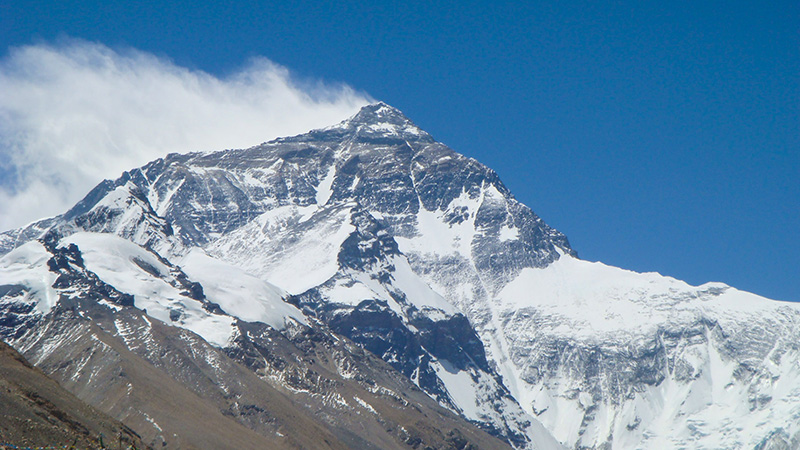 Mount Everest
Mount Everest
- Chinese: 日喀则
- Elevation: Around 3,800 m (12,467 ft)
Shigatse is the second-largest city in Tibet, located southwest of Lhasa. It is a major cultural and religious city and serves as the traditional seat of the Panchen Lama, the second-highest figure in Tibetan Buddhism. The highest mountain, Everest, lies on the China-Nepal boundary. So, if you wish to get a closer view of Mount Everest, heading to Shigatse will be a wise choice.
Highlights in Shigatse:
- Everest Base Camp: It's a popular destination for travelers who want to get close to Mount Everest, the world's highest peak. It offers stunning views of Everest's north face and has been a must-visit for you if you're seeking adventure, breathtaking scenery, and a glimpse into life on the "Roof of the World."
- Sakya Monastery: The monastery features a fortress-like design, which is different from traditional Tibetan monasteries. It has thick grey walls and red, white, and black stripes representing the three Bodhisattvas. However, inside the monastery, you can still find classic Tibetan things.
3. Shannan, Cradle of Tibetan Culture
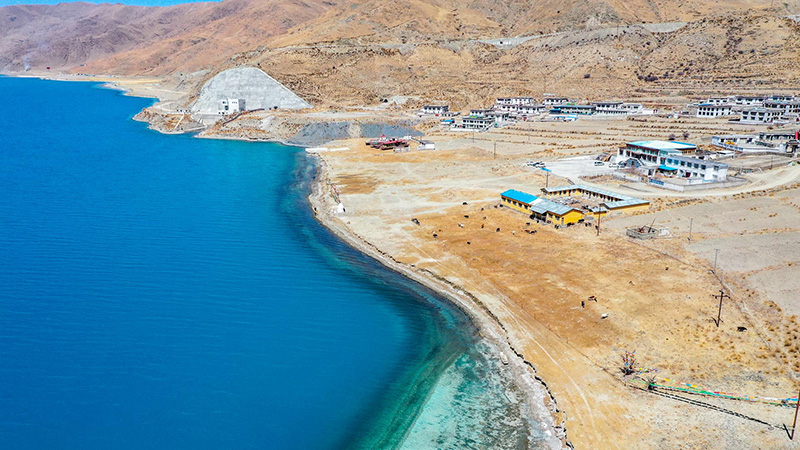 Lake Yamdrok
Lake Yamdrok
- Chinese: 山南
- Elevation: Around 3,700 meters (12,140 ft)
Shannan, also known as Lhoka, is a culturally rich region in southern Tibet, bordering Bhutan and India. It's often referred to as the "cradle of Tibetan civilization," as many aspects of Tibetan culture originated here. For example, Tibetan kings first established their rule and Buddhism began to take root in Shannan. The region features ancient sites, sacred lakes, and serene landscapes.
Highlights in Shannan:
- Samye Monastery: It is the first Buddhist monastery ever built in Tibet, founded in the 8th century. The monastery's design represents a mandala, symbolizing the Buddhist universe, with a central temple surrounded by smaller structures. Samye combines Tibetan, Indian, and Chinese architectural styles, reflecting the diverse influences on early Tibetan Buddhism.
- Lake Yamdrok: This lake is also known as Yamdrok Yumtso and is one of the three sacred lakes in Tibet. The lake is known for its stunning turquoise-blue color, which changes with sunlight. Lake Yamdrok is considered holy by Tibetans and is believed to be the spiritual guardian of the region. You can stop by and admire it on the way to Karola Glaciers or Everest Base Camp at Mount Everest for its breathtaking scenery and cultural significance.
4. Ngari (Ali), Westmost and Sacred
 Mount Kailash in a distance
Mount Kailash in a distance
- Chinese: 阿里
- Elevation: over 4,500 meters (14,764 ft)
Ngari (Ali) is a remote and mystical region in western Tibet, often called the "Roof of the" due to its extreme altitude and rugged beauty. It is the least populated area in Tibet but holds immense spiritual and historical significance.
Highlights in Ali:
- Mt. Kailash: a sacred mountain in western Tibet, standing at 6,638 meters (21,778 feet). Unlike Mount Everest, Mount Kailash is not climbed; instead, you may trek the kora around it to enjoy the view and cultural atmosphere.
- Lake Manasarovar: This lake is one of the most sacred and beautiful high-altitude freshwater lakes in the world. It's located in Ngari Prefecture, western Tibet, near the base of Mount Kailash. Pilgrims believe that bathing in or drinking the water can wash away sins and bring spiritual merit.
5. Nyingchi, The Garden of Tibet
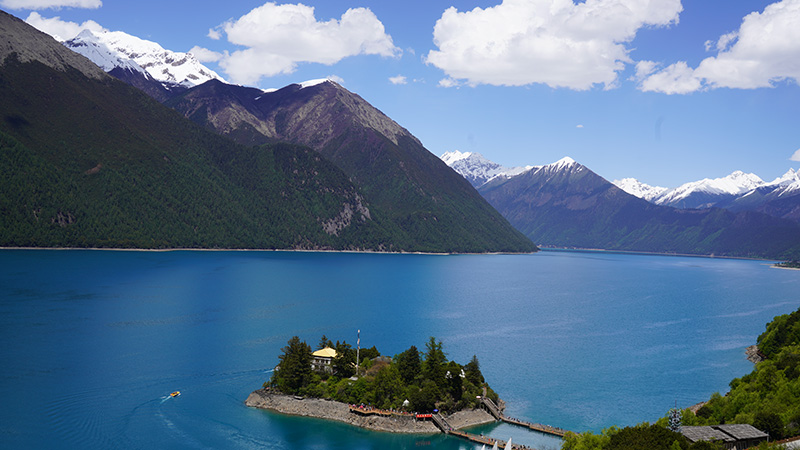 Lake Namtso
Lake Namtso
- Chinese: 林芝
- Elevation: Around 3,000 m (9,842 ft)
Nyingchi is in southeastern Tibet. It sits at a lower elevation, making it more accessible and lush compared to other parts of Tibet. With its forested valleys, rivers, and snow-capped peaks, it's often called the most scenic and fertile area in Tibet.
Highlights in Nyinchi:
- Nyingchi Peach Blossom Festival: If you're looking for a unique view in northwestern China, consider attending the Nyingchi Peach Blossom Festival in spring (around March and April). This is the best time to celebrate the explosion of peach blossoms set against snow-capped mountains.
- Basum Tso Lake: This lake is a serene turquoise lake nestled among snow-capped peaks and dense forests. It feels like a Himalayan fairy tale when you walk by the lake, as it offers lush scenery, which is different from the dry Tibetan Plateau.
- Without a doubt, the view in Nyingchi is amazing. However, there are few places that are not open for foreign tourists.
- Yarlung Tsangpo Grand Canyon near - The deepest canyon in the world
- Pailong Zangbo Canyon and certain sections of the Yarlung Tsangpo River
Recommended Tour Itinerary
5 Must-Try Tibetan Foods
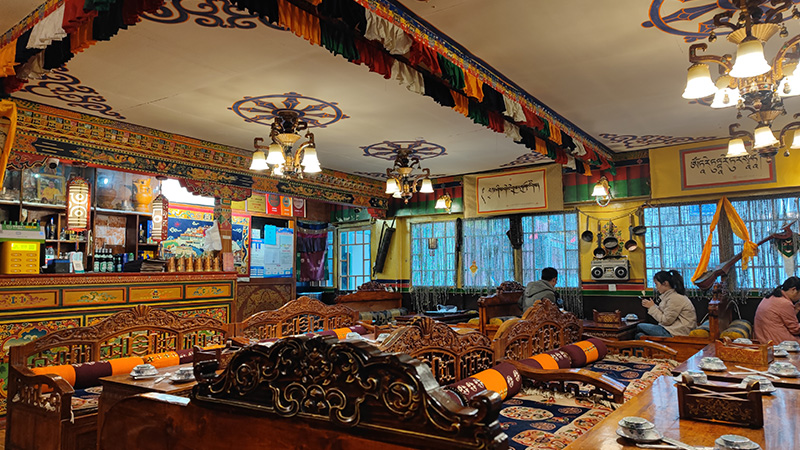 A local restaurant with Tibetan decoration
A local restaurant with Tibetan decoration
Tibetan food is shaped by the region's high-altitude climate and nomadic lifestyle, making it high in calories and protein. Staples in Tibet include yak meat, mutton, barley, and dairy products like butter, cheese, and yogurt. Here are some Tibetan foods most recommended for visitors.
Tsampa
Tsampa is a traditional Tibetan breakfast made from roasted barley flour. You will be served with a bowl of barley flour and some yak butter or butter tea. You can mix them together to form a dough. And then, you can have it. In a word, it's like making a fresh bun on your own.
Butter Tea
You may have tried or heard of China's bubble tea, but Tibetan butter tea will offer you a completely new experience. In Tibet, local people have butter tea in their daily lives. It is a blend of yak butter, strong black tea, and salt. So it would taste not as sweet as bubble tea, and a bit salty.
Thukpa
Thukpa is a traditional Tibetan noodle soup, hearty and flavorful, often enjoyed as a comforting meal in cold weather. It's widely popular not only in Tibet but also in areas around Himalaya, such as Nepal, Bhutan, and parts of northern India.
A bowl of classic Thukpa in Tibet includes freshmade noodles, vegetables (like cabbage, carrots, onions), and meat (commonly yak or beef). Since this dish was originally eaten in winter to keep warm, ingredients like garlic, ginger, or chili are often added to the soup to help raise body temperature.
Yak Meat Hotpot
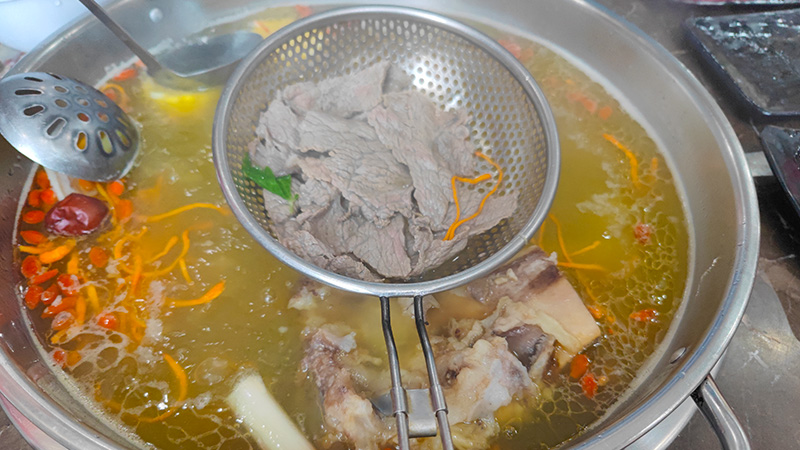 Fresh cooked yak meat
Fresh cooked yak meat
Yak meat hotpot is also a must-try in Tibet. It's often shared at Tibetan family and friends gathering. The soup is flavorful with garlic, ginger, and Tibetan herbs, offering a unique taste. Just like Sichuan hotpot, it starts with a pot of broth, while the meat and vegetables are served on separate plates for you to cook yourself. You can first taste the rich beef bone broth, then gradually add the ingredients you like.
Yak Cheese & Yogurt
In addition to yak meat, yak dairy products are also a specialty of Tibet. Due to the high-altitude environment, yak milk is more nutritious, with a slightly higher protein content than common cow’s milk products. There are several recommended dairy products for you:
- Chhurpi: a kind of air-dried, hard and chewy yak cheese in Nepal and Tibet, often chewed like gum.
- Yak Yogurt: It's creamier and thicker than cow's milk yogurt. The taste is richer and slightly more sour, with a pleasant tang. It's more recommended to add some sugar before have it.
Where to Stay in Tibet
 Clean room of an inn near Mount Everest
Clean room of an inn near Mount Everest
Though Tibet is relatively remote, the accommodation conditions are actually not bad. There are 4- and 5-stars in Lhasa, as well as in central areas in other cities, like Shigatse, Gyantse, Nyingchi, etc. There are even 3-stars near Everest Base Camp.
We do not recommend staying in local residents' homes for two reasons: First, most local residents have strong religious beliefs, so it's best to maintain distance in unfamiliar situations. Second, the living conditions in local homes are generally modest, and staying in a hotel might offer more comfort.
How to Get to Tibet
 Scenery from a Tibet train
Scenery from a Tibet train
Tibet is located in the far west of China, and it's a vast region - about five times the size of the UK and roughly one-seventh the size of the United States. Because of this, traveling within Tibet takes more time, and long-distance journeys can result in higher transportation costs.
The main entry and exit point is Lhasa, the capital of Tibet. Typically, you can fly or take a train to Lhasa first, then travel to other regions from there.
One important thing to note is that you must travel in Tibet with a licensed local tour guide, and you'll need a Tibet Travel Permit, which must be arranged for you by a travel agency in advance.
Find more detailed information in: Tibet Transportation Guide
Plan a Guided Tibet Tour With Us
A journey to Tibet is unlike any other - breathtaking landscapes, rich spiritual traditions, and unforgettable cultural encounters await you on the Roof of the World. Let us help you explore this extraordinary land with ease, comfort, and insight, alone with applying for Tibet Travel Permit and arraging exclusive travel guide. Just click here, or email trip@odynovotours.com, our travel experts will reach you within 24 hours.
Related Posts You May Like
What Our Clients Say
"Great Customized Service", "Trip of A Lifetime", "Exceed All Expectations"
